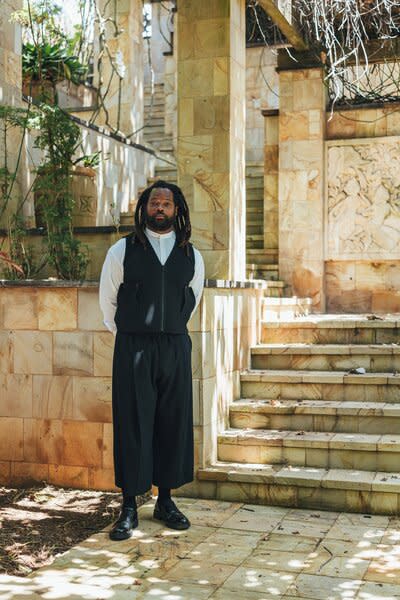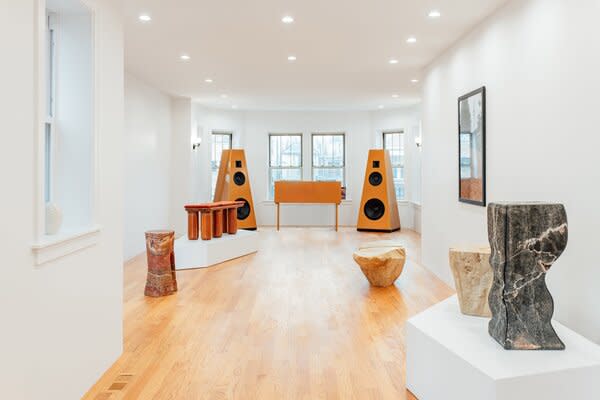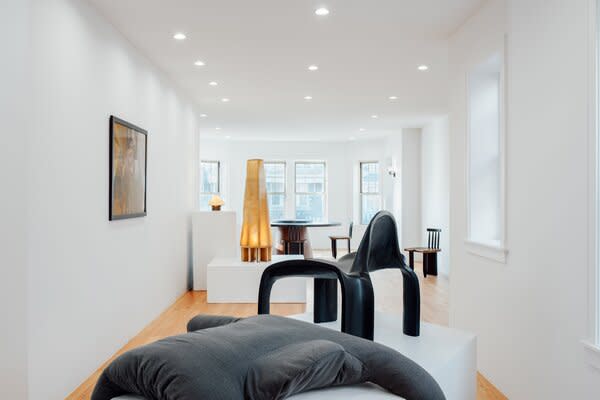How a Former NFL Player Is Keeping the Past Alive Using Design
After leaving pro sports, Michael Bennett is still thinking about bodies moving in time—just on a different scale.

Michael Bennett has always been an artist. The former Seattle Seahawks defensive end and 2013 Super Bowl champ spent much of his youth in constant discipline, channeling what he calls, "the duality of the body and mind." For Bennett, athleticism is an artistic practice, coordinating between bodies in space and time—though that space was usually a large stadium filled with fans, marked by a countdown clock.
But over the past four years, he has been expanding this practice to explore the mind-body dichotomy through furniture and architectural design under the brand Studio Kër. In this new practice, he thinks about "deep time"—connecting with his ancestral roots to produce domestic objects and spaces, ranging from seating and tables to sculpture and installation, that speak to diasporic experiences and traditions.
When Bennett retired from the NFL in 2020, he had been thinking about going into design and kept returning to one particular word: Communion. "Communion was this idea of spiritual, intimate conversation—spiritual, intimate growth," he says. "And that was very challenging because in 2020, we didn’t have that." He was remembering, as a child growing up in Louisiana and Texas, what "coming together" looked like: watching his mother braid his sister’s hair, or Sunday dinners. But after traveling to his ancestral Senegal, where he observed and absorbed the materials, cultures, and objects of his heritage as an African-American man, these histories began colliding.
"I’m thinking of this African diasporic language—being an African American, which is, by definition, an African who’s an American who has this lineage to Africa—in finding ways to discover what that looks like in architecture, in form, in objects," Bennett says.
Bennett studied at the University of Hawai‘i’s School of Architecture, and in 2023 presented two new pieces: Urban Decay, a sculptural installation of concrete layered with plastic refuse, displayed in Honolulu’s Hawai‘i Walls art festival; and Public Display, a gathering space built from cross-laminated timber (CLT) that includes custom box seats shaded by a cantilevered roof for the NYCxDesign Festival. Materials—concrete, garbage, CLT—were prominent in both; he notes that material has become integral to his storytelling.
"Looking back at the Senegalese oral tradition, telling stories, to me that's the muse of my design philosophy. I’m thinking about this notion of objects being relics and objects being living repositories and embodying this cultural dialogue," Bennett says. He uses materials like wood, metals, and stone that have connections to African design and craft that also "hold onto" histories because of their durability. "These materials are alive," he says, "they are living repositories."
Bennett’s most recent body of work was unveiled in Chicago at the Rebuild Foundation’s 6 Flat gallery this month. Titled "We Gotta Get Back to the Crib," the exhibition includes a new series of furniture designed by Bennett and his late collaborator, Imhotep Blot, who shared Bennett’s Haitian and Senegalese backgrounds. "The crib," in this setting, refers not just to the series of smooth, curved chairs or large dining table that could adorn a home; it’s also a reference to the state of being home, says Bennett.
"It’s about getting back to the core principles of who you are, the core principles of culture, and connecting back to family," Bennett explains. "When I get into these moments of doubt and fear, the crib is this place where I go into to hibernate and come back stronger. Sometimes you get lost but then you can connect back to culture and principles—you find your way again. That’s what the crib is, an exploration of Blackness and a sense of getting back to the elements of craftsmanship, history, storytelling—who we are in the culture and how things connect."
See the full story on Dwell.com: How a Former NFL Player Is Keeping the Past Alive Using Design
Related stories:




